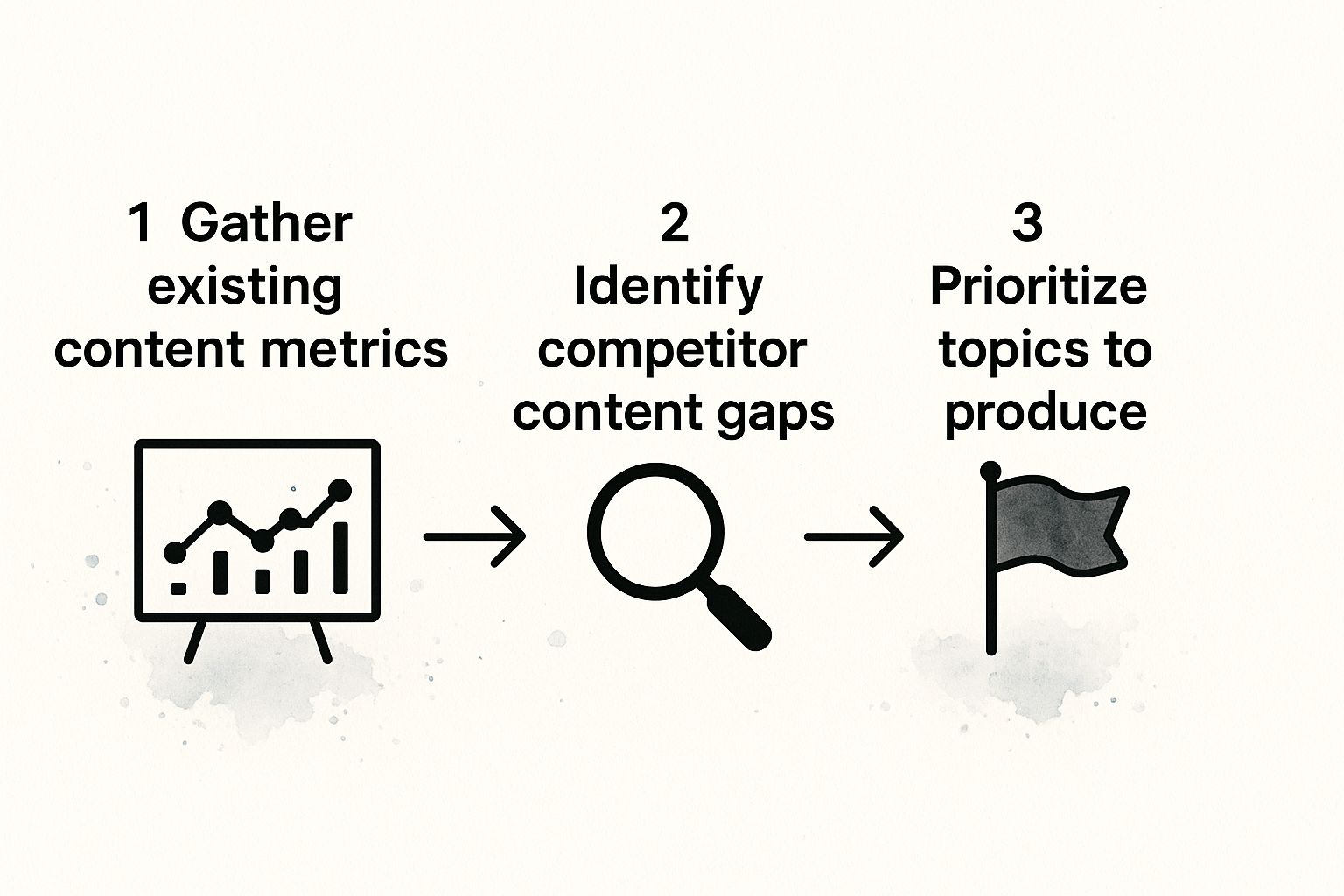Let's be honest: a content gap analysis isn't just another box to tick on your SEO to-do list. It's a core growth strategy. Thinking of it any other way is like leaving the front door wide open for your competitors to walk in and scoop up your potential audience.
This process is about more than just finding keywords you don't rank for. It's about systematically identifying the topics your customers care about that you're completely ignoring.

Find Untapped Traffic and Build Real Authority
Every single content gap you find is a pocket of undiscovered organic traffic just waiting for you. When you create truly valuable content to fill those holes, you do more than just attract new visitors. You start building topical authority, which sends a powerful signal to search engines that you're a comprehensive resource in your niche.
This has never been more critical. Search algorithms are getting smarter about penalizing thin, generic content. A content gap analysis forces you to pinpoint exactly where your competitors are winning and which of your own pages are falling flat.
The biggest breakthroughs I've ever had came from looking where no one else was. A content gap analysis literally hands you a map to those underserved topics and unanswered customer questions.
Turn a Simple Audit into a Powerful Strategy
A thorough analysis doesn't just give you a list of keywords to chase. It should inform your entire content roadmap. It's a foundational piece of an effective overall ecommerce content strategy and gives you a serious competitive edge.
Instead of just looking at keywords, a modern audit has several layers. We're not just checking boxes; we're looking for strategic opportunities across different formats and topic clusters.
Core Components of a Modern Content Audit
This table breaks down the key areas to investigate. Think of it as moving beyond a simple checklist to a more holistic, strategic view of your content landscape.
| Audit Component | What to Look For | Strategic Importance |
|---|---|---|
| Keyword Gaps | Specific keywords your competitors rank for on page one, but you don't. | This is your low-hanging fruit for capturing qualified traffic your rivals currently own. |
| Topic Gaps | Entire subject areas and sub-topics your audience cares about that you haven't covered at all. | Fills crucial holes in your expertise, builds topical authority, and serves the entire user journey. |
| Format Gaps | Competitors succeeding with videos, tools, or infographics while you only write blog posts. | Diversifies your content portfolio to match user intent and appeal to different learning styles. |
| Funnel Gaps | Missing content for specific stages of the buyer's journey (e.g., comparison or decision-stage content). | Ensures you're not losing potential customers at critical moments in their path to purchase. |
By systematically looking at these different types of "gaps," you can build a much more robust and defensible content plan. If you want to dive deeper into building a content engine that actually drives growth, check out the resources on the https://rebelgrowth.com/blog. This approach transforms a simple audit into a measurable growth driver for your business.
Assembling Your Toolkit for Effective Analysis
Before you start digging for those hidden content opportunities, you need to get your tools in order. A solid content gap analysis hinges on having the right software and, just as importantly, a crystal-clear picture of your own digital territory.
Think of it like getting ready for an expedition—you wouldn’t set out without a map and a compass.

Your journey starts with a couple of powerful SEO platforms. These are the workhorses that do the heavy lifting, automating the data collection and competitor research that would take ages to do manually.
The Core SEO Platforms
The two heavyweights in this space are Semrush and Ahrefs. While both are packed with features, their keyword and competitor analysis functions are what you'll lean on for a content gap analysis. They let you quickly see where your rivals are ranking and you aren't.
But don't overlook the free, foundational data you can get straight from the source. Google Search Console is non-negotiable. It shows you exactly which queries are already bringing people to your site. This gives you a baseline of your current performance and can shine a light on underperforming pages that need a boost.
Your Most Important Data Source: Your Own Content
A tool is only as good as the data you feed it. That's why the most crucial first step is to get your own house in order with a thorough audit of your existing content. This creates the foundational inventory of what you already have, which is essential for an accurate analysis later on.
This means auditing your entire content library—not just blog posts. You need to look at everything from website copy and landing pages to social media, ebooks, and even marketing emails. This is how you'll find missing topics or underserved search intents, as detailed in this complete guide to content gap analysis.
A content audit isn't just about what you have; it's about what you don't have. The biggest opportunities are often found in the silence—the topics you've never even touched.
To get started, spin up a simple spreadsheet to inventory all your content. This doesn't need to be some overly complicated beast. The goal is to create a single source of truth about your digital assets.
Essential Fields for Your Content Inventory:
- URL: The direct link to the content piece.
- Content Title: The H1 or primary title of the page.
- Content Type: Is it a blog post, a landing page, a product description, a case study, or a video?
- Primary Keyword: The main keyword the page is trying to target.
- Organic Traffic (Last 90 Days): Pull this data from Google Analytics or Search Console.
- Top 3 Keywords: The main queries the page actually ranks for, which you can find in Google Search Console.
This initial audit does more than just list your assets; it forces you to get real about your content's performance. You’ll immediately spot the pages that are dead weight and those that are punching way above their class. This inventory becomes the "Your Domain" part of the equation when you use tools to compare your site against competitors. It sets the stage for a much more accurate and impactful analysis.
Uncovering Your Competitors' Winning Content
Now for the fun part—the detective work. This is where you get to systematically deconstruct your competitors' content strategy to find your biggest opportunities. A good content gap analysis at this stage is less about abstract theory and more about tactical espionage.
We're going to dig way deeper than just a surface-level keyword list. The real goal here is to pinpoint the exact content formats and topics that are crushing it for them, so you can turn around and build something even better.

Identifying Your True Content Rivals
First things first, you need to be crystal clear on who you're actually up against. It's a common mistake to assume your main business competitors are also your primary content competitors. They often aren't.
You could be fighting for search attention with a niche blogger, a major industry publication, or even an affiliate site that just happens to dominate your topics. The easiest way to find out? Just run a few Google searches for your most important target keywords. The sites that consistently pop up on page one are your true content rivals—those are the ones you need to analyze.
Using SEO Tools for Keyword Gaps
This is where the heavy-lifting tools like Semrush and Ahrefs really shine. Their "keyword gap" or "content gap" features are built for exactly this kind of work. The process is straightforward: you pop in your domain, add two or three of your top competitors, and let the tool do its magic.
What you get back is a list of keywords they rank for that you don't. This is your initial treasure map of opportunities.
Of course, a raw list of thousands of keywords is more overwhelming than helpful. The secret is filtering this data to find the real gold. I always recommend narrowing your focus to keywords where:
- Your competitors already rank in the top 10.
- The keyword difficulty (KD) is in a range you can realistically compete for.
- The search intent is a perfect match for your business goals.
For example, a project management SaaS company should zero in on keywords containing modifiers like "template," "alternative," or "how to," since these signal a user who is actively looking for solutions.
A Practical SaaS Scenario
Let's say you're launching a new project management tool, and you're up against a couple of established giants. A quick keyword gap analysis reveals they both rank highly for terms like "Gantt chart template" and "project timeline examples," but your website has absolutely nothing on these topics.
Bingo. That’s a massive, glaring content gap. You've just uncovered a specific need your target audience has—one that your competitors are happily fulfilling while you're sitting on the sidelines.
Don't just find the keywords your competitors rank for. You have to analyze why their content ranks. Is it a free tool? A downloadable template? A super-detailed video? The format is often just as important as the topic itself.
Analyzing the 'Why' Behind the Ranking
A keyword list only tells you what to target. To actually win the top spot, you need to understand why your competitor's page is so successful in the first place. For every high-priority opportunity on your list, you have to roll up your sleeves and dig into the top-ranking pages.
Ask yourself these critical questions:
- What's the format? Is it a beast of a long-form blog post, a video tutorial, a landing page with a nifty free tool, or a simple downloadable PDF?
- How thorough is it? Does it just scratch the surface, or is it the most comprehensive resource on the entire web for that topic?
- What is the user trying to do? Is the page for someone looking to learn (informational), compare options (transactional), or make a purchase (commercial)?
This deeper analysis is what turns raw data into a strategic action plan. Instead of just deciding to "write a blog post about Gantt charts," you might realize what you really need is to create an "interactive Gantt chart template builder." Why? Because that’s the format that best serves the user's intent and completely outshines what the competition is offering. This is how you move from just filling gaps to creating truly superior content.
Got a big list of keywords and topics from your content gap analysis? Great. But on its own, it’s just a bunch of noise.
To get real results from those opportunities, you need to connect each one to a specific stage in the customer journey. This is the critical step that transforms your focus from just chasing traffic to actually driving business outcomes.
It all comes down to understanding user intent. Is someone just figuring out they have a problem? Are they actively weighing their options? Or are they on the verge of making a decision? When you can answer that, you can create content that meets them at the perfect moment—not too early, not too late.
Categorizing Gaps by User Intent
The customer journey usually boils down to three main stages. Every single content gap you’ve found will fit neatly into one of these buckets, which is how you start to understand its strategic value.
Awareness: This is the top of your funnel. People at this stage have a problem, but they might not even know a solution like yours exists. They’re using broad, informational search queries like “how to increase website traffic” or “why is my social media engagement so low.”
Consideration: Welcome to the middle of the funnel. Now, users are actively researching and comparing different solutions. Their searches get more specific, like “best project management tools for small business” or “Mailchimp vs. Constant Contact.”
Decision: At the bottom of the funnel, you’ve got people who are ready to pull the trigger. Their intent is transactional, and they’re searching for things like “Rebelgrowth pricing” or “Semrush free trial.” Content here is all about building that last bit of trust and knocking down any final barriers. For example, perfectly designed landing pages are absolutely essential for converting this high-intent traffic.
A classic mistake is pouring all your resources into top-of-funnel, awareness-stage content. Sure, it casts a wide net, but if you ignore the consideration and decision stages, you’re just attracting visitors you’ll never convert into actual customers.
Building a Practical Content Map
Once you start sorting your keyword and topic gaps into these categories, you can build out a content map. This doesn't have to be complicated—a simple spreadsheet usually does the trick. What it does is connect every potential piece of content to a funnel stage and a clear business goal.
This map gives you instant clarity. It turns your analysis into a concrete, actionable plan.
Let’s say you uncover a huge gap around the topic “social media scheduling tool alternatives.” That’s a textbook Consideration stage opportunity. Your move isn't just to write a blog post. It's to create a detailed comparison guide that highlights why your product is the superior choice.
Or maybe you find gaps around branded keywords for a direct competitor. That’s a bottom-of-funnel play. The goal is to create content that intercepts that traffic, like a “Competitor vs. Your Brand” page that puts your unique selling points front and center.
By aligning every gap with a journey stage, you ensure that every article, guide, or video you create has a real purpose and directly supports your business goals.
Building Your Prioritized Content Action Plan
You've done the detective work, gathered the data, and now you’re sitting on a goldmine of potential content ideas. But a long list of opportunities can be just as paralyzing as having none. This is where your content gap analysis transforms from a research document into a focused, actionable roadmap.
The key is to create a simple system for prioritizing what to tackle first. Without a clear plan, teams often gravitate toward the easiest topics, not necessarily the most impactful ones. We need a method to identify the true quick wins while strategically planning for the bigger, resource-heavy projects.
This visual gives you a high-level look at how to turn that raw data into a list of prioritized topics.

Following this flow—from gathering metrics to prioritizing topics—ensures your final action plan is grounded in both competitive data and your own business goals.
Creating a Simple Scoring Model
To bring some order to the chaos, let's create a simple scoring model. This helps take emotion and guesswork out of the equation, replacing it with a data-informed approach. For each content idea on your list, you'll assign a score from 1 (low) to 5 (high) across a few key dimensions.
- Business Relevance (Score 1-5): How closely does this topic align with your core product or service? A topic directly tied to a feature you offer should get a 5. A broader, top-of-funnel topic might get a 2.
- Search Volume (Score 1-5): What's the potential traffic here? Use your SEO tool to get a feel for the monthly search volume and score it accordingly. High volume isn't always the goal, but it’s an important piece of the puzzle.
- Competitive Difficulty (Score 1-5): How hard will it actually be to rank? This is crucial. A low-difficulty topic you can realistically own is way more valuable than a high-volume keyword dominated by industry giants. So, a lower keyword difficulty score in your tool means a higher score (a 5) here.
The real magic happens when you find a topic with high business relevance, decent search volume, and low competitive difficulty. That’s your sweet spot—the low-hanging fruit you should jump on immediately.
Adding a Resource Factor
Okay, one last, crucial piece for your model: resource intensity. This isn't a score but a realistic check-in on what it will actually take to create this piece of content.
I like to break it down into simple categories.
Resource Intensity Categories: * Low: A straightforward blog post or a quick update to an existing page. * Medium: A detailed guide with custom graphics or an in-depth case study. * High: A video series, an interactive tool, or original research that requires serious time and budget.
Once you combine the scores with this resource assessment, your priorities become crystal clear. A high-scoring idea with low resource needs is a "do it now" task. A high-scoring idea that needs a lot of resources? That's a Q2 or Q3 project you need to start planning for.
This structured approach is what turns your content gap analysis from a messy spreadsheet into a concrete, executable plan your team can rally behind.
Got Questions About Content Gap Analysis?
When teams first start exploring content gap analysis, a few common questions always pop up. Let's get those cleared up right now. Answering these will give you the confidence to dive in and make this a regular part of how you grow.
How Often Should I Perform This Analysis?
For a full-blown, deep-dive analysis, I'd block this out on your calendar annually or maybe twice a year. That gives you enough time to actually act on what you found last time and see some real results before you tear everything down again.
But things move fast online, don't they? That's why I'm a big fan of smaller, quarterly check-ins. These are perfect for reacting to a big Google update, a new competitor suddenly showing up, or a noticeable shift in what your customers are searching for. Staying agile is the name of the game.
Can I Do This Without Expensive Tools?
You absolutely can. Look, premium platforms like Ahrefs or Semrush make this process incredibly fast and efficient, but you can get surprisingly far with free tools. It just takes a bit more elbow grease.
Start with Google Search Console—it literally tells you which keywords you're already getting traffic for. From there, pop over to Google's Keyword Planner to brainstorm new ideas. Finally, you'll have to put in some time manually digging through the top-ranking sites for your target terms. It's more time-consuming, sure, but the core insights are all there waiting for you.
The biggest mistake is thinking you can't compete just because a rival has a massive budget. A content gap analysis is your secret weapon to find their weaknesses. You win by being more strategic, not by outspending them.
What Is the Difference Between a Keyword Gap and a Content Gap?
This is a fantastic question because people throw these terms around interchangeably, but they really aren't the same thing.
- A keyword gap is super specific. It's all about the keywords your competitors rank for, but you don't. Simple as that.
- A content gap is much broader. It definitely includes keyword gaps, but it also zooms out to look at entire topics you're missing, user intents you aren't serving well, and even different content formats (like videos, free tools, or case studies) that you aren't producing.
Thinking about gaps on a global scale can really put things in perspective. For instance, over 2.57 billion people still have zero internet access, which creates massive content vacuums in entire regions. You can find more on this global digital divide in the latest WeAreSocial report.
How Can I Realistically Compete Against Huge Competitors?
Whatever you do, don't try to fight them on every single front—that's a battle you'll lose. Instead, use your analysis to pinpoint their blind spots.
Go after the niche, long-tail keywords they've completely ignored. Target very specific questions from users that their generic content answers poorly. Or, create a super-valuable resource in a format they don't even offer, like an interactive tool or a detailed infographic. You can find a huge range of marketing tools and resources in our RebelGrawth directory to help you find that competitive edge.
Ready to stop guessing and start growing? rebelgrowth gives you the AI-powered tools you need to perform a content gap analysis, generate high-ranking blog posts, and dominate your niche. Start your journey with Rebelgrowth today.
